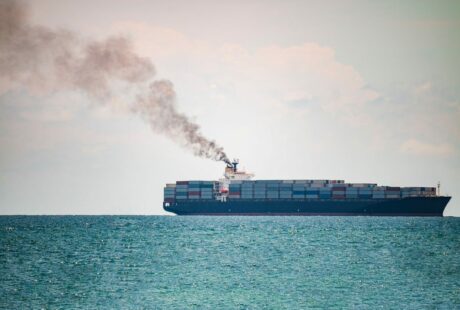Recent IPCC reports and the developments at the COP26 Climate Summit in Glasgow are a wake-up call that the UN’s International Maritime Organization (IMO) cannot ignore. Countries must now build on their commitments to save the Paris Agreement’s 1.5° temperature goal with concrete action and halve shipping emissions by 2030 at the IMO.
There is currently no strategy in place at the IMO to achieve any significant ship emission reductions before 2030, let alone the reductions necessary to keep the sector on a pathway consistent with warming below 1.5°. Under the current IMO regulations ship emissions continue to rise out to 2030 and the shipping industry will exhaust its 1.5 degree carbon budget by 2029.
At next week’s 77th session of IMO’s Marine Environment Protection Committee (“MEPC77”), IMO member states must urgently align the agency’s work on reducing climate impacts from shipping with the COP26 developments.
In particular, countries have the opportunity to:
- Align shipping with the 1.5° degrees target: commit to reducing ship climate impacts on a timeframe consistent with keeping warming below 1.5°, including reaching zero by 2050 at the latest and halving emissions by 2030;
- Bolster short-term measures: reopen discussions on the level of ambition in the IMO’s short-term measure with a view to agreeing new targets consistent with halving emissions by 2030;
- Tackle black carbon: take decisive action to address the impact on the Arctic of black carbon emissions, a short-lived climate forcer responsible for 20% of shipping climate impact; and
- Set a GHG levy: agree a minimum $100/tonne levy on GHG emissions to raise climate finance and support a just transition to zero across the sector as called for at COP26.
These actions constitute a significant increase in the ambition of IMO’s climate work but they are necessary if we want the shipping industry to contribute to keeping global heating below 1.5° and save billions of people around the world from climate chaos.
The COP26 summit has already laid an important foundation for this shift, as:
- 54 climate-vulnerable countries signed the Dhaka-Glasgow declaration, demanding a carbon levy on ship fuel;
- 22 countries agreed to set up decarbonised shipping corridors through the Clydebank Declaration;
- 14 countries endorsed the Declaration on Zero Emission Shipping by 2050.
We applaud the signatories for their climate leadership and urge them to make their presence felt at MEPC77. We insist that they stick to their positions on aligning with the 1.5° temperature goal, thereby having to halve shipping emissions by 2030, and support a carbon levy inside the IMO as well as outside it.
We will continue monitoring closely the discussion at the IMO to make sure climate commitments at COP26 translate into concrete action.
In addition to Seas at Risk this statement is supported by Clean Shipping Coalition, Clean Arctic Alliance, Global Choices, Opportunity Green, Pacific Environment, Greenpeace, WWF- Canada, Environmental Defense Fund, and ECODES.
Background information:
On COP26:
55 Climate Vulnerable Forum countries (of which 47 are IMO member states) signed the Dhaka-Glasgow declaration, which includes a maritime segment supporting a greenhouse gas (GHG) levy, i.e. carbon price, that aligns shipping emissions with a 1.5° pathway at the IMO.
Of course, a 1.5° pathway, according to the IPCC, requires a 45% reduction in global emissions by 2030, and reaching zero overall emissions before 2050. This means the declaration carries explicit support for deep emission cuts this decade, a greenhouse gas levy, and implicit support for strengthening the zero emissions by 2050 goal.
22 countries signed the Clydebank Declaration to create “green corridors” for zero-carbon shipping by 2025. Making these shipping routes commercially viable will require either a significant carbon price of between $200-400/mt, or equivalent strength fuel standards incentivising immediate uptake of zero, not just low, carbon fuels.
14 countries signed the Declaration on Zero Emission Shipping by 2050: This brings the total to 49 countries supporting zero shipping emissions by 2050 (including 8 CVF Asia branch members who supported zero by 2050 in a statement in late September).
By adding the remaining CVF members, who as noted above have supported a 1.5° temperature goal that requires zero emissions by 2050, this brings the total number to 93 countries supporting climate-neutral shipping by 2050. This is a clear majority of the IMO’s total 175 member states.
On shipping:
Generally, around 90% of all traded goods are transported across oceans on cargo vessels, currently all powered by fossil fuels such as heavy fuel oil. The IMO estimates that shipping currently accounts for almost 3% of all global greenhouse gas emissions. Researchers warn that by 2050 this could well represent up to 10% of all emissions.
The sector also produces up to 15% of the world’s manufactured sulfur oxide and nitrous oxide emissions, which disproportionately impact low income communities of color living near ports. As a result, shipping emissions are linked to an estimated 6.4 million global childhood asthma cases and 260,000 premature deaths annually.
On black carbon:
Black carbon (BC) is a powerful, short-lived climate pollutant which has a disproportionate impact when emitted in or near the Arctic. BC emissions from Arctic shipping increased 85% between 2015 and 2019. Action to reduce BC emissions will improve human health as well as mitigate climate change. As a first step to tackling this problem at MEPC77, IMO Members should adopt a Resolution on BC urging voluntary use of distillate fuel with low aromaticity by ships operating in and near to the Arctic.
Posted on: 18 November 2021



